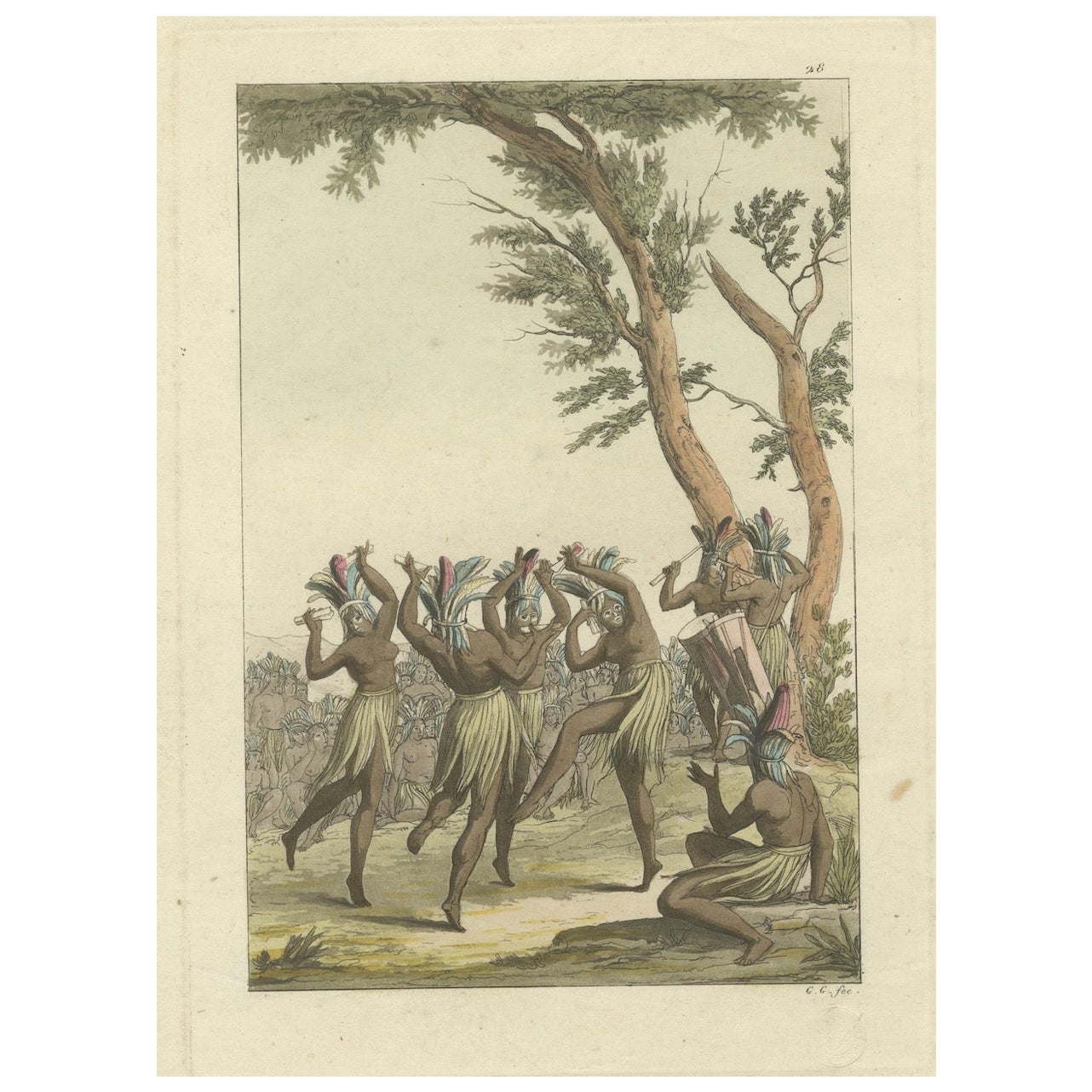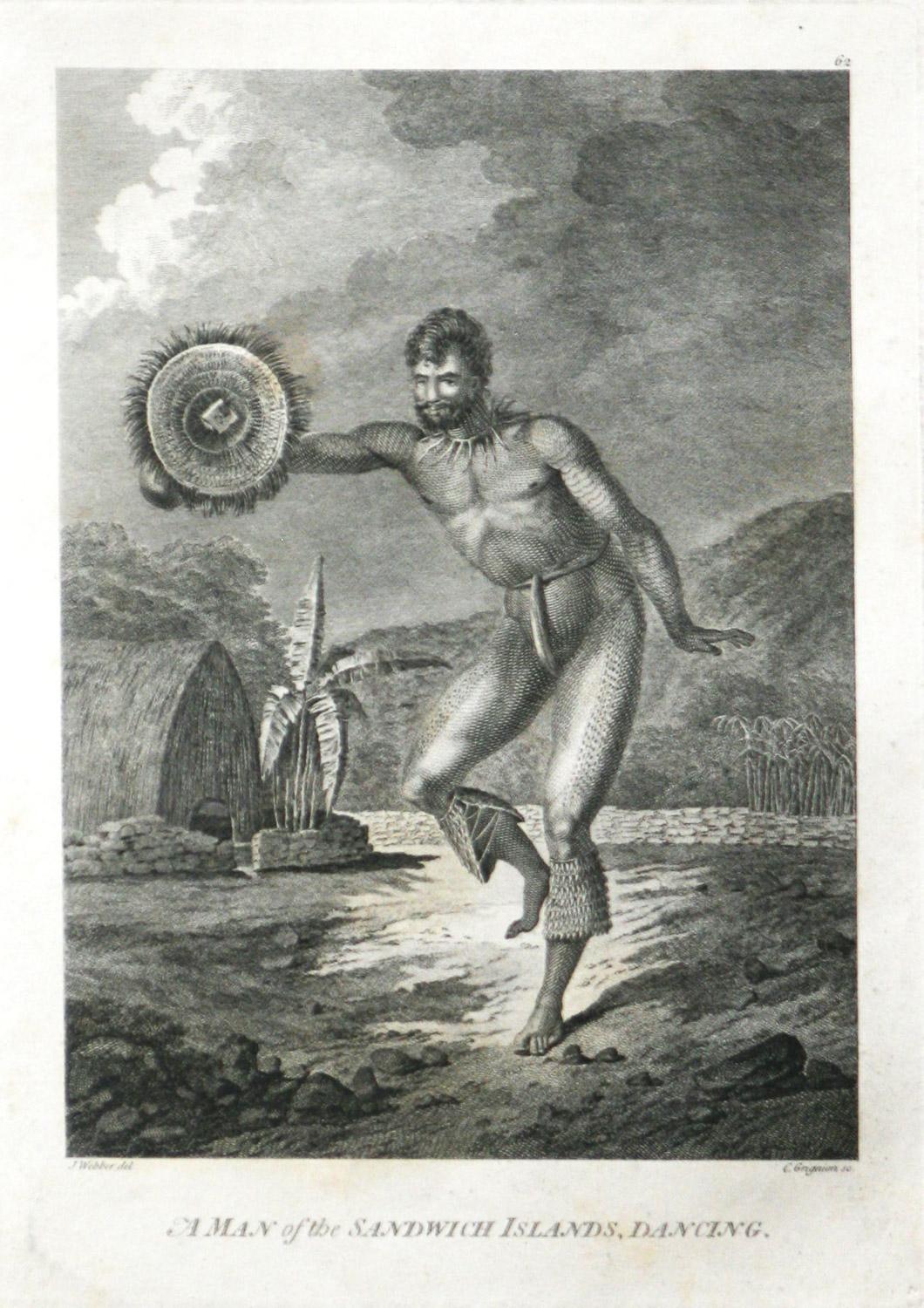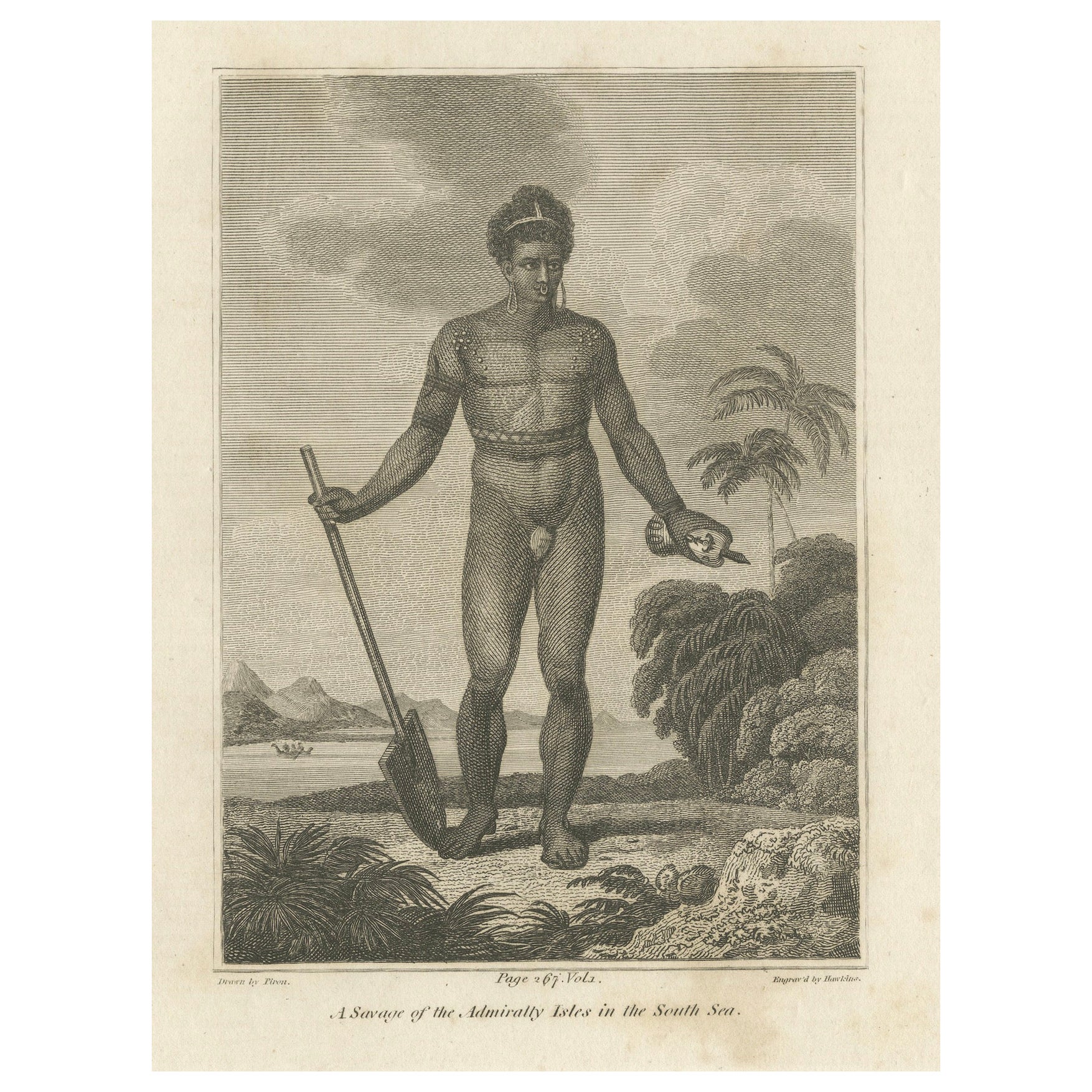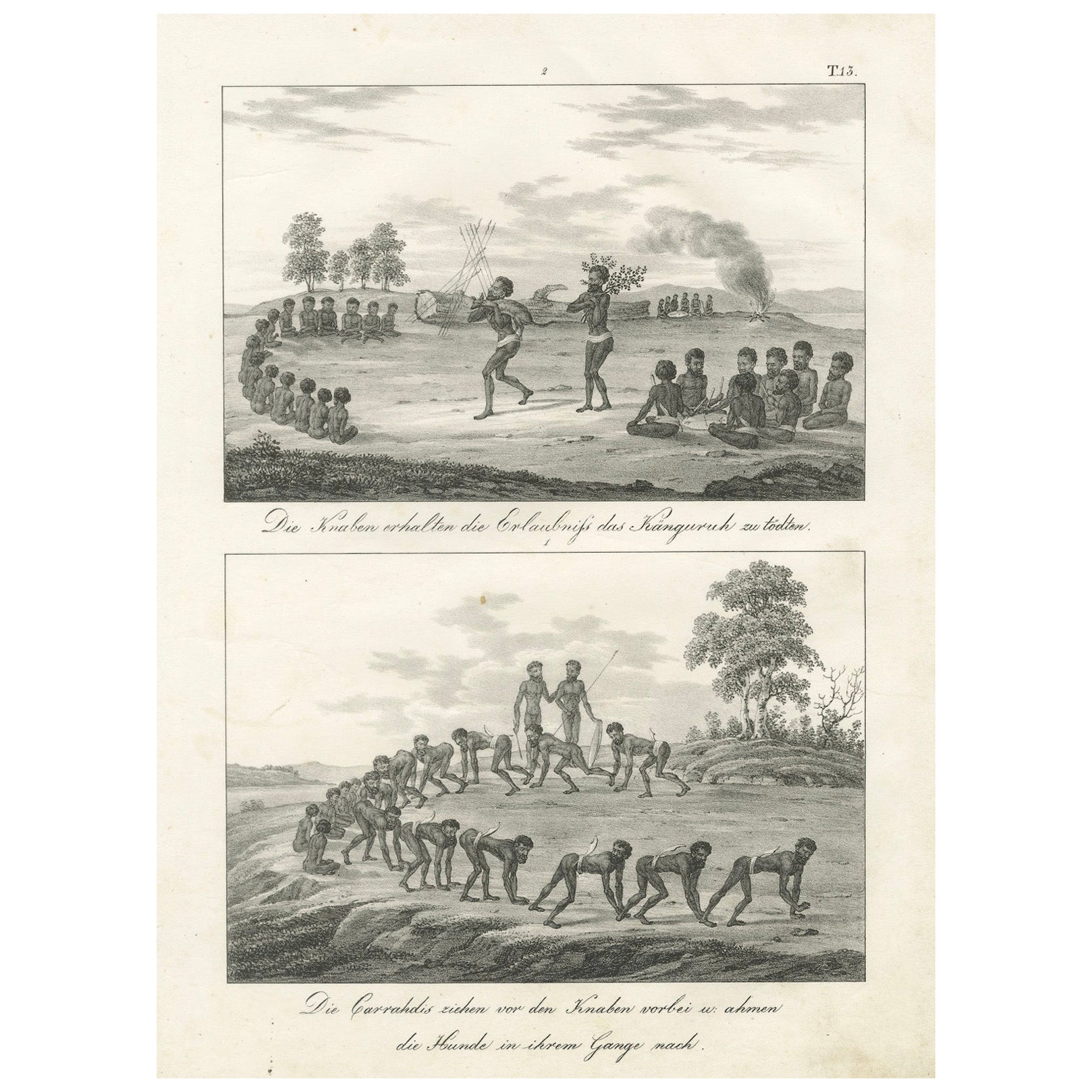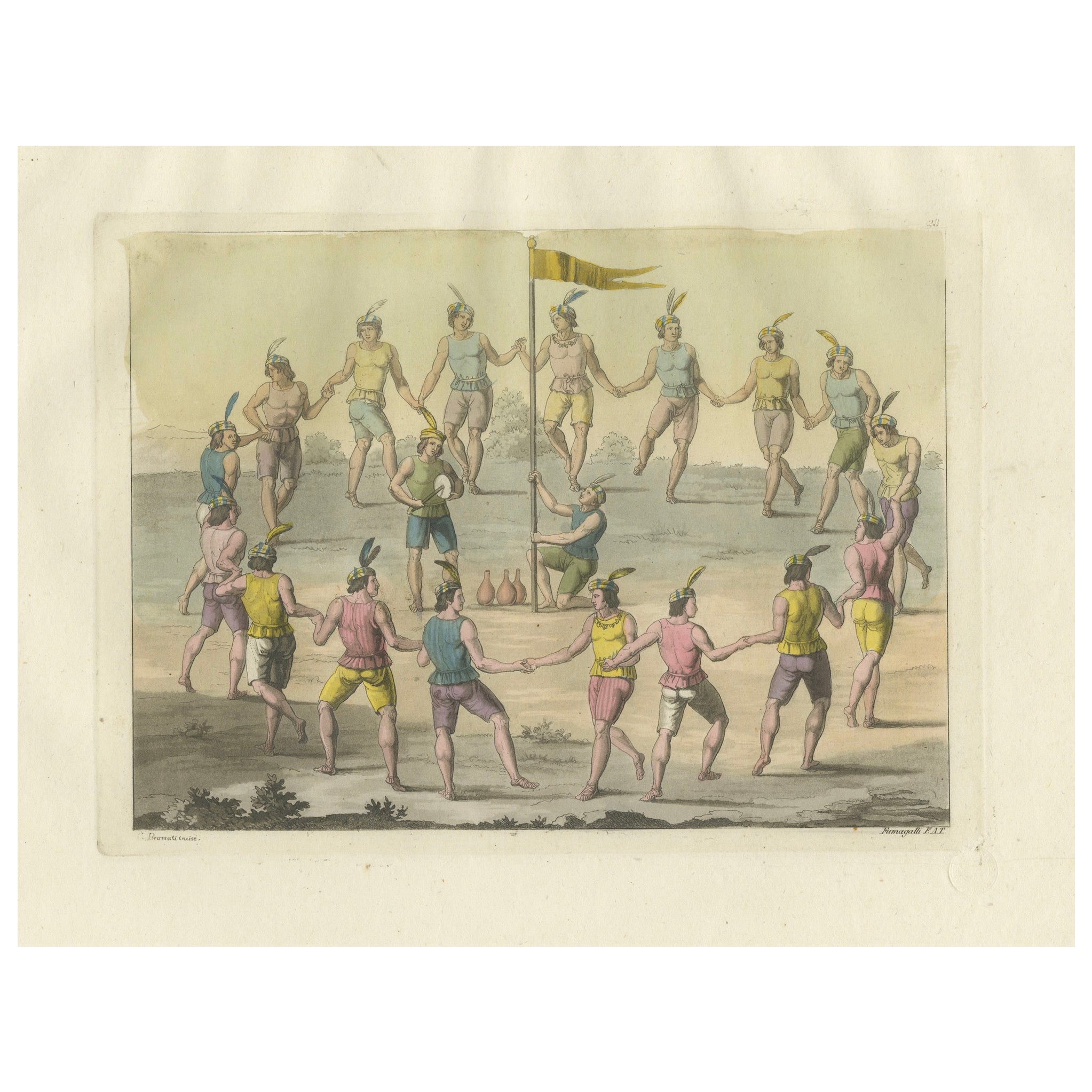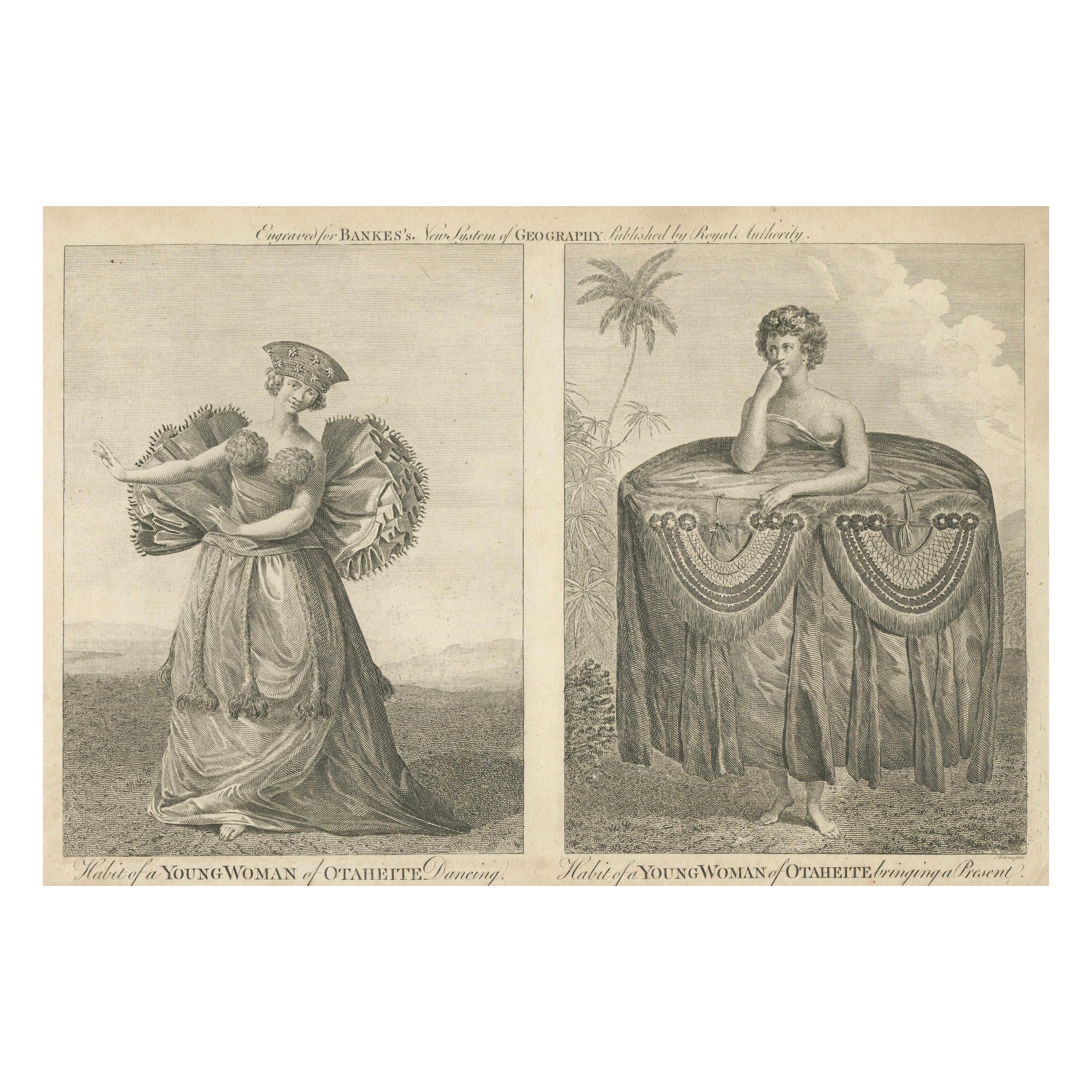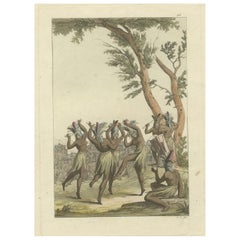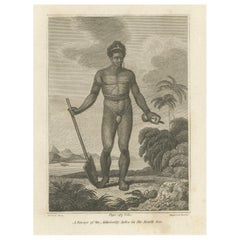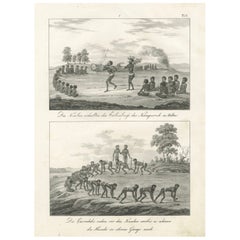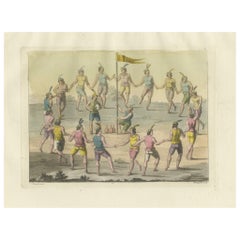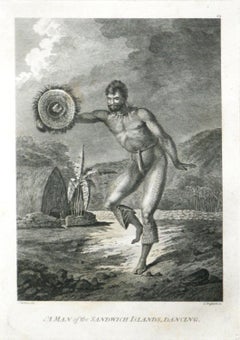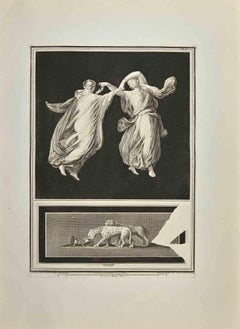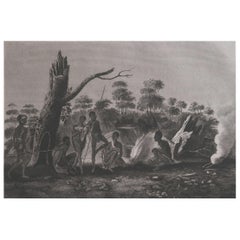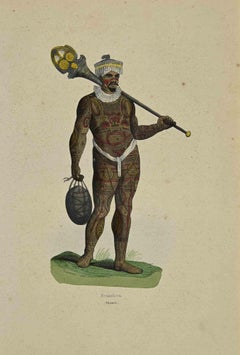Items Similar to Movement and Tradition: A Sandwich Islander's Dance in the 18th Century, 1788
Want more images or videos?
Request additional images or videos from the seller
1 of 10
Movement and Tradition: A Sandwich Islander's Dance in the 18th Century, 1788
$182.12
$227.6520% Off
£135.55
£169.4420% Off
€152
€19020% Off
CA$249.46
CA$311.8220% Off
A$277.45
A$346.8120% Off
CHF 144.88
CHF 181.0920% Off
MX$3,376.26
MX$4,220.3320% Off
NOK 1,850.28
NOK 2,312.8520% Off
SEK 1,735.24
SEK 2,169.0520% Off
DKK 1,157.12
DKK 1,446.4020% Off
Shipping
Retrieving quote...The 1stDibs Promise:
Authenticity Guarantee,
Money-Back Guarantee,
24-Hour Cancellation
About the Item
The image is an original antique engraving from "Bankes's New System of Geography," which depicts "A Man of the Sandwich Islands Dancing." The term "Sandwich Islands" was the name given to the Hawaiian Islands by James Cook in honor of the Earl of Sandwich when he visited them on his third Pacific voyage.
The illustration shows a man in a dynamic pose, with one arm extended, holding what appears to be a feathered object, possibly a kāla‘au, which are rhythm sticks used in traditional Hawaiian hula and chants. The man's other hand is placed on his hip, and his posture and facial expression convey motion, suggesting he is in the midst of a dance. His tattooed legs and the woven decorations on his ankles and wrists suggest cultural adornments that were significant in the traditional dress of Hawaiian men.
Such images were meant to capture and convey the customs and lifestyles of the peoples encountered during explorations to European audiences who were curious about these distant lands.
- Dimensions:Height: 13 in (33 cm)Width: 8.47 in (21.5 cm)Depth: 0 in (0.02 mm)
- Materials and Techniques:Paper,Engraved
- Period:1780-1789
- Date of Manufacture:1788
- Condition:Repaired: Left lower corner has been supported by archival tape on the reverse. Good condition. Aged paper with sometimes light brownish edges, showing small creases and soiling due to age and handling. One small pinhole to the right of his feet, hardly visible. Study the images carefully.
- Seller Location:Langweer, NL
- Reference Number:Seller: BG-13599-431stDibs: LU3054338013612
About the Seller
5.0
Recognized Seller
These prestigious sellers are industry leaders and represent the highest echelon for item quality and design.
Platinum Seller
Premium sellers with a 4.7+ rating and 24-hour response times
Established in 2009
1stDibs seller since 2017
2,508 sales on 1stDibs
Typical response time: <1 hour
- ShippingRetrieving quote...Shipping from: Langweer, Netherlands
- Return Policy
Authenticity Guarantee
In the unlikely event there’s an issue with an item’s authenticity, contact us within 1 year for a full refund. DetailsMoney-Back Guarantee
If your item is not as described, is damaged in transit, or does not arrive, contact us within 7 days for a full refund. Details24-Hour Cancellation
You have a 24-hour grace period in which to reconsider your purchase, with no questions asked.Vetted Professional Sellers
Our world-class sellers must adhere to strict standards for service and quality, maintaining the integrity of our listings.Price-Match Guarantee
If you find that a seller listed the same item for a lower price elsewhere, we’ll match it.Trusted Global Delivery
Our best-in-class carrier network provides specialized shipping options worldwide, including custom delivery.More From This Seller
View AllRitual Dance: Expressions of Cultural Heritage in an African Ceremony, 1827
Located in Langweer, NL
The print is from "Il Costume Antico e Moderno" by Giulio Ferrario, specifically depicting the "Le Lullunge" feast in Senegambia. This festival is illustrated as part of the extensive series detailing the customs, costumes, and daily life of people from different parts of the world. The illustration captures a lively and culturally significant dance that forms part of the "Le Lullunge" celebrations, showcasing traditional attire and communal participation, which are central to the event in Senegambian culture. The illustration not only serves as a vibrant representation of the dance and celebration but also as an ethnographic record from the early 19th century, emphasizing the richness of Senegambian traditions.
The term "Senegambia" historically referred to a region in West Africa that encompassed parts of what are today known as Senegal and The Gambia. This area is known for its rich cultural heritage, including vibrant festivals and communal celebrations like the one depicted in the illustration. The "Le Lullunge" feast, as illustrated in Giulio Ferrario's "Il Costume Antico e Moderno," captures the traditional dances and social practices of the peoples in this West African region.
This original antique hand-colored print depicts a vibrant scene of Native African dance, possibly part of a ceremonial or ritualistic activity. The individuals are animatedly engaged in dance, with their limbs dynamically positioned, suggesting vigorous movement. Each figure is adorned with elaborate feathered headdresses and carries feathers or other items as part of their dance. These accessories likely have cultural significance, possibly denoting status, role in the ceremony, or spiritual symbolism.
The attire of the dancers is simple yet functional for their vigorous activity, consisting of skirts that allow for ease of movement. Their outfits are decorated with additional elements that may indicate tribal affiliation or personal achievement. The dancers are barefoot, connecting them physically and symbolically to the earth, which is a common aspect in many African cultural practices emphasizing a connection to nature.
The setting of the dance is outdoors, under a large tree, indicating the importance of natural surroundings for the event. This could be a communal gathering place, chosen for its significance within their community or for its natural beauty and tranquility.
Overall, this image captures a moment of cultural expression, highlighting the importance of dance in Native African traditions as a form of communication, celebration, or spiritual practice. The detail and color used in the depiction aim to convey the vibrancy and energy of the scene, reflecting the artist’s perspective on these cultural practices.
In more detail:
From: ‘Il Costume Antico e Moderno …, l’America.’ , by Giulio Ferrario, published in Milan in 21 volumes by Antonio Fortunato Stella in 1827 (first edition, second issue). The 17 volumes of the first issue were published sequentially between c. 1815/1816 until 1826 after first being issued in 143 weekly installments. The work appeared in Italian and French. Smaller size editions with smaller much less elaborate plates were published in Florence (1823-38), Naples (1831-42) and even a 16mo. editon in Livorno (1830). Original blindstamp at bottom right image. The sources used for this work are wide.
Made by ‘Gallo Gallina’ after ‘Giulio Ferrario’. Giulio Ferrario was founder of the ‘Societa Tipografica de Classici Italiani’ and served as the director of the Braidense National Library in Milan, Italy. Artists that worked on this monumental work are: Gallo Gallina, D.K. Bonatti, A. Biasioli, L. Rossi, Paolo Fumagalli, Gaetano Zancon (1771-1816), G. Bigatti, C. Bramati, G. Gallo, C. Bottiglia, G. Castellini, Antonio Rancati (1784-1816), Vittorio Raineri, Sydney Parkinson...
Category
Antique 1820s Prints
Materials
Paper
$239 Sale Price
20% Off
Engraving of A Savage of the Admiralty Isles in the Bismarck Archipelago, 1801
Located in Langweer, NL
The 1801 engraving depicts a figure labeled as "A Savage of the Admiralty Isles in the South Sea." The image portrays a solitary indigenous man standing with a paddle in hand, exudin...
Category
Antique Early 1800s Prints
Materials
Paper
$325 Sale Price
20% Off
Free Shipping
Indigenous Rituals and Ceremonies of New Holland, Published iin 1836
Located in Langweer, NL
Title: Indigenous Rituals and Ceremonies of New Holland
Description: This lithograph, circa 1836, offers a glimpse into the cultural practices of Indigenous Australians in New Hol...
Category
Antique 1830s Prints
Materials
Paper
Engraving of Traditional Chilean Circle Dance: A Festive Gathering in 1827 Chile
Located in Langweer, NL
Antique print titled "Danze de' Chiliesi" (Dance of the Chileans), from the historical work "Il Costume Antico e Moderno" by Giulio Ferrario. The print, created in 1821, showcases a traditional Chilean dance, vividly captured in line and aquatint etching with original hand coloring on wove (vellin) paper.
The scene depicts a group of Chilean dancers in a circular formation, engaging in a traditional dance. The dancers are adorned in colorful attire, featuring breechcloths, leggings, and vibrant headdresses with feathers, which reflect their cultural heritage and the festive nature of the dance. The setting is outdoors, possibly during a community celebration or ritual, indicated by the natural backdrop and the casual yet organized arrangement of the figures.
Cultural and Historical Significance
This print is significant as it provides a visual documentation of Chilean cultural practices from the early 19th century, emphasizing the traditional dances that were an integral part of community gatherings and celebrations. The artwork, by C. Bramati and Paolo Fumagalli after designs by Giulio Ferrario, is part of a larger series that aimed to capture the costumes and customs of people around the world, offering insights into the diversity of cultural expressions during a time of burgeoning global awareness.
The detailed depiction not only highlights the dance but also serves as an ethnographic record, preserving aspects of Chilean culture that might have evolved or faded over time. This work, along with others in the series, was widely distributed and appreciated for its educational and artistic value, making significant contributions to the understanding of global cultural heritage in the 19th century.
‘Tavole XXVIII. Danze de’ Chiliesi.’
Line & aquatint etching with original hand colouring on wove (vellin) paper.
Sheet size: 33 x 23,5 cm. (13 x 9,3 inch). Image size: 21 x 15,5 cm. (8,3 x 6,1 inch).
In more detail:
From: ‘Il Costume Antico e Moderno …, l’America.’ , by Giulio Ferrario, published in Milan in 17 volumes (first issue), published sequentially between c. 1815/1816 until 1826 after first being issued in 143 weekly installments. This Italian volume has the date 1821. The second issue was published in 21 volumes in 1827. The work appeared in Italian and French. Smaller size editions with smaller much less elaborate plates were published in Florence (1823-38), Naples (1831-42) and even a 16mo. editon in Livorno (1830). Original blindstamp at bottom right image. The sources used for this work are wide including van Humboldt, von Wied etc.
Made by ‘C. Bramati and Paola Fumagalli’ after ‘Giulio Ferrario’. Giulio Ferrario was founder of the ‘Societa Tipografica de Classici Italiani’ and served as the director of the Braidense National Library in Milan, Italy. Artists that worked on this monumental work are: Gallo Gallina, D.K. Bonatti, A. Biasioli, L. Rossi, Paolo Fumagalli, Gaetano Zancon (1771-1816), G. Bigatti, C. Bramati, G. Gallo, C. Bottiglia, G. Castellini, Antonio Rancati (1784-1816), Vittorio Raineri, Sydney Parkinson...
Category
Antique 1820s Prints
Materials
Paper
$373 Sale Price
20% Off
Cultural Habits of Tahitian Women: Dance and Ceremony, circa 1790
Located in Langweer, NL
This engraving is titled "Habits of a Young Woman of Otaheite", and it was produced as part of Bankes's New System of Geography, which was a popular geographical work published in th...
Category
Antique 1790s Prints
Materials
Paper
$153 Sale Price
20% Off
Rhythms of the Pacific: A Communal Dance in Tonga, Engraving Published in 1812
Located in Langweer, NL
The engraving depicts a serene and communal scene labeled as "Dance in the Friendly Isles." The Friendly Isles is an older name for the Kingdom of Tonga in the South Pacific. This pi...
Category
Antique Early 19th Century Prints
Materials
Paper
$249 Sale Price
20% Off
Free Shipping
You May Also Like
A Man of the Sandwich Islands, Dancing (Hawaii) from Captain Cooks travels engra
By John Webber
Located in Paonia, CO
A Man of the Sandwich Islands Dancing (Hawaii) is from the 1784 First Edition Atlas Accompanying Capt. James Cook and King; Third and Final Voyage of Captain James Cook. John Webber (1752-1793) was the official artist for the third voyage of Captain James Cook (1728-1779). The purpose of this voyage was to discover the Northwest Passage and to explore the Pacific Ocean north of the Equator. These engravings were published in 1784-85 by G. Nichol and Thomas Cadell of London in the four large format atlas, Voyage to the Pacific Ocean. Captain Cook was an extraordinary explorer known for discovering and mapping unknown territory and for his many contributions to the scientific world. These original engravings from Webber’s drawings and paintings are only a glimpse into this great man’s historical contributions that make him one of the greatest explorers of all times.
This image shows a Hawaiian dancer...
Category
1780s Realist Figurative Prints
Materials
Engraving
Dance Fresco - Etching by Nicola Billy - 18th Century
Located in Roma, IT
Dance Fresco from "Antiquities of Herculaneum" is an etching on paper realized by Nicola Billy in the 18th Century.
Signed on the plate.
Good conditions with some folding due to th...
Category
18th Century Old Masters Figurative Prints
Materials
Etching
Original Antique Ethnographical Print, Figures, New South Wales, Australia, 1809
Located in St Annes, Lancashire
Wonderful ethnographical print.
A copper-plate engraving after Lesieur
Published by Sherwood, Neely & Jones. Dated 1809
Unframed.
Category
Antique Early 1800s English Folk Art Prints
Materials
Paper
Noukahiwa - Lithograph by Auguste Wahlen - 1844
Located in Roma, IT
Noukahiwa is a hand colored lithographs realized by Auguste Wahlen in 1844.
Good conditions.
The artwork belongsto the Suite Moeurs, usages et costume...
Category
1840s Modern Figurative Prints
Materials
Lithograph
Indigenous Costumes - Original Lithograph - 19th Century
Located in Roma, IT
Indigenous Costumes is an original lithograph realized by an anonymous engraver of the 19th Century.
Printed as part of the series "France Pittoresque", as indicated at the top cent...
Category
19th Century Figurative Prints
Materials
Lithograph
Exercise - Original Etching by Thomas Holloway - 1810
By Thomas Holloway
Located in Roma, IT
Exercise is an original artwork realized by Thomas Holloway for Johann Caspar Lavater's "Essays on Physiognomy, Designed to promote the Knowledge and the Love of Mankind", London, B...
Category
1810s Modern Figurative Prints
Materials
Etching
More Ways To Browse
Buddha Mandalas
Buddha With Dragon
Burl Bedside Chests
Butcher Head
Cast Iron Japanese Garden
Castle Clock
Ceramic Goose
Ceramic Owls
Chariot Clock
Checkerboard Board
Chest Of Drawers With Pull Out Desk
Chinese Altar Vase
Chinese Carved Celadon Jade
Chinese Cloisonne Plate
Chinese Dragon Embroidered
Chinese Emperor Empress
Chinese Enamel Teapot
Chinese Frog
